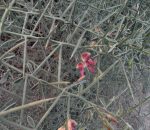
Also known as Caspian manna, and Persian mannaplant this deciduous shrub is indigenous to temperate and tropical Eurasia and the Middle East where it grows in both wetlands and deserts. It is a member of the pea family, Fabaceae, that also includes beans, mimosa, and black locust. The low scrubby plant grows up to 6.7′ tall and has an extensive creeping root system and many much- branched stems with thin hairy twigs and an abundance of long, slender, axillary spines. The gray-green leaves are wedge-shaped, hairless, and 1/4 inch long. In summer, axillary racemes of pink to maroon pea-like flowers appear and give way to half moon-shaped, brown or reddish pods with constrictions between the mottled brown seeds. Wikimedia Commons
During the warm part of the day the stems and leaves produce a sweet gummy exude that hardens on contact with air and is collected and eaten. The grain offerings mentioned in the passage below have been identified as the resinous gum derived from trees native to the Levant including prickly alhagi (Alhagi maurorm), flowering ash (Fraxinus ornus) and manna tamarisk (Tamarix mannifera).
Baruch 1:10 (GNT) The Jews living in Babylon wrote a letter to the people of Judah.
“The people wrote: Please use the money we are sending you to buy animals for the burnt offerings and the sin offerings, to buy incense, and to provide the grain offerings. Offer them on the altar of the Lord our God,”
Camel thorn likes full sun and has a wide soil tolerance including sandy, rocky, dry, and saline but particularly does well when growing near a source of water. It is hardy in USDA Hardiness Zones 6-10. Propagation is by seed, division of rhizomes, and cuttings of young shoots. Camel thorn has beeen valued as a folk medicine and is consumed as a famine food. It is unpalatable to animals, however, and considered an invasive weed in some areas, especially grazing land.
The genus name, Alhagi, is derived from the Arabic word meaning pilgrim. The specific epithet, maurorum, is the Latin word meaning of the Moors.